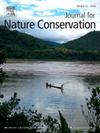Exploration of the coupling coordination between rural tourism development and agricultural eco-efficiency in islands: A case study of Hainan Island in China
IF 2.2
3区 环境科学与生态学
Q2 BIODIVERSITY CONSERVATION
引用次数: 0
Abstract
The coordinated development of rural tourism and ecological agriculture on islands is crucial for fostering sustainable human-ocean interactions. Existing research does not provide a detailed analysis of the relationship between rural tourism development (RTD) and agricultural eco-efficiency (AEE) from an island-based perspective. This study examines the 18 directly governed cities and counties of Hainan Island, China, as a case study to evaluate the intensity of RTD and AEE. Furthermore, the coupling coordination degree model and Geodetector are applied to analyze the spatial characteristics and driving factors influencing the coordinated development of RTD and AEE on Hainan Island. The results show: (1) Rural tourism spots on Hainan Island exhibit a spatial distribution characterized by high density in the south and lower density in the east and west, forming a “dual-center, block-shaped aggregation” pattern; (2) AEE on Hainan Island follows a “single-core development” pattern, characterized by centralized and contiguous areas with Sanya City as the nucleus, forming a single-core ecological agriculture zone; (3) The average coupling coordination degree between RTD and AEE on Hainan Island is 0.612, signifying a moderate level of coordination with notable disparities between the northern and southern regions; (4) The primary drivers of the spatial evolution of coordinated development are social, educational, and economic development levels, with explanatory powers of 0.592, 0.500, and 0.410, respectively. This research provides meaningful insights into the integrated development of rural tourism and ecological agriculture on islands.
岛屿乡村旅游与生态农业的协调发展对于促进可持续的人海互动至关重要。现有研究并未从岛屿角度详细分析乡村旅游发展(RTD)与农业生态效益(AEE)之间的关系。本研究以中国海南岛 18 个直辖市县为例,评估了乡村旅游发展(RTD)与农业生态效益(AEE)的强度。此外,还应用耦合协调度模型和 Geodetector 分析了影响海南岛 RTD 和 AEE 协调发展的空间特征和驱动因素。结果表明:(1)海南岛乡村旅游点在空间分布上呈现出南部密度高、东西部密度低的特点,形成了 "双中心、块状聚集 "的格局;(2)海南岛AEE呈现出 "单核发展 "的格局,其特点是以三亚市为核心集中连片,形成了单核生态农业区;(3)海南岛RTD与AEE的平均耦合协调度为0.612,协调程度中等,南北差异显著;(4)社会、教育和经济发展水平是协调发展空间演化的主要驱动因素,其解释力分别为 0.592、0.500 和 0.410。这项研究为海岛乡村旅游与生态农业的融合发展提供了有意义的启示。
本文章由计算机程序翻译,如有差异,请以英文原文为准。
求助全文
约1分钟内获得全文
求助全文
来源期刊

Journal for Nature Conservation
环境科学-生态学
CiteScore
3.70
自引率
5.00%
发文量
151
审稿时长
7.9 weeks
期刊介绍:
The Journal for Nature Conservation addresses concepts, methods and techniques for nature conservation. This international and interdisciplinary journal encourages collaboration between scientists and practitioners, including the integration of biodiversity issues with social and economic concepts. Therefore, conceptual, technical and methodological papers, as well as reviews, research papers, and short communications are welcomed from a wide range of disciplines, including theoretical ecology, landscape ecology, restoration ecology, ecological modelling, and others, provided that there is a clear connection and immediate relevance to nature conservation.
Manuscripts without any immediate conservation context, such as inventories, distribution modelling, genetic studies, animal behaviour, plant physiology, will not be considered for this journal; though such data may be useful for conservationists and managers in the future, this is outside of the current scope of the journal.
 求助内容:
求助内容: 应助结果提醒方式:
应助结果提醒方式:


